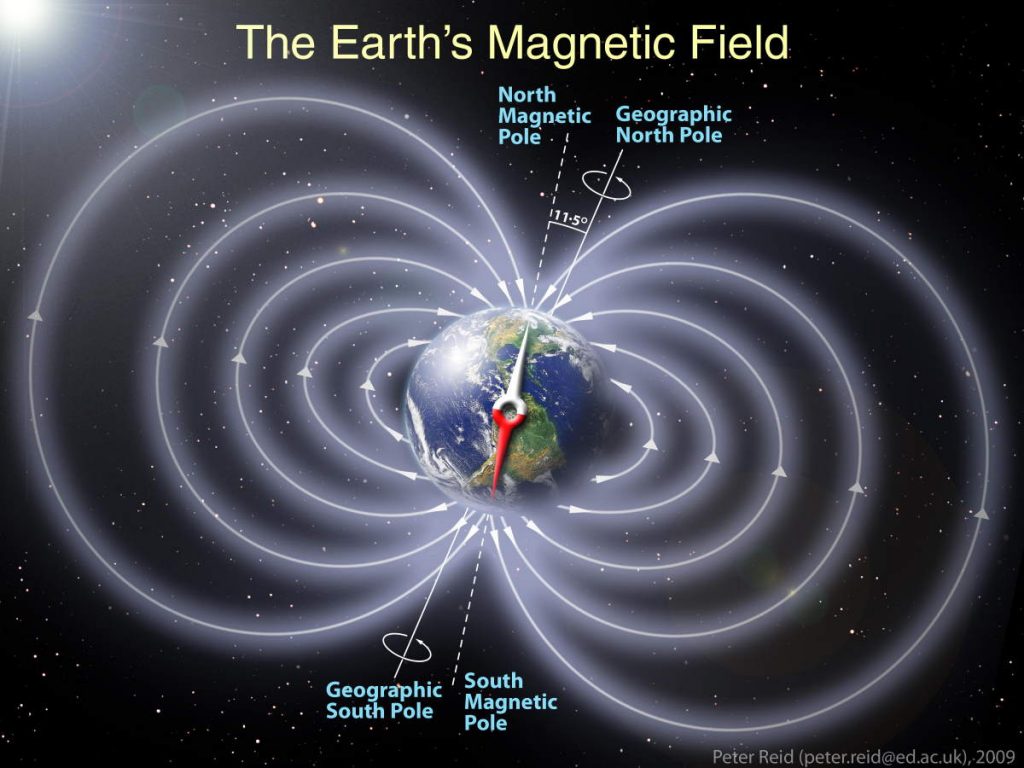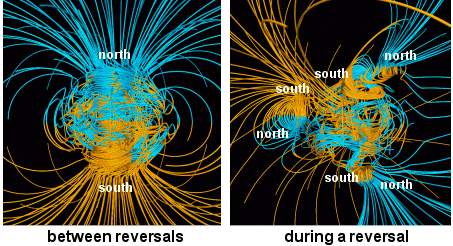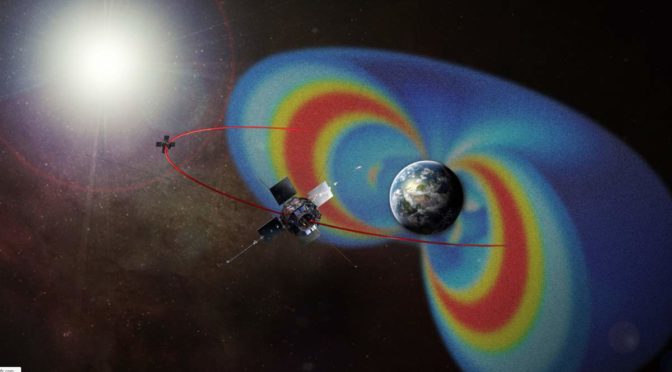The magnetic field of Earth is constantly changing. And, at the moment, even more rapidly than previously thought – up to 10 times, as British researchers have now figured out. This has significant implications not just for the old-school magnetic compass navigation but also for the proper functioning of telecommunications networks and GPS – and thus for airlines, emergency services, and the military.
The Earth’s magnetic field, which protects us from cosmic ray bombardment, is continuously shifting and our planet’s magnetic poles are moving away from the geographical poles (see notes 1). The pole is inverted in extreme cases: the north magnetic pole becomes the south pole and vice versa. Once they are very far away from the geographical poles, the magnetic poles travel very quickly.
Furthermore, at the same time, the magnetic field of Earth is changing its direction. This process happens at varying speeds. Geologists have been able to prove this for a global magnetic field reversal that occurred 41,000 years ago. Around 2000 years later, this was followed by a phase in which the magnetic field shifted by around 2.5 degrees per year and significantly weakened along Central America’s western coastline.
The magnetic field of Earth can change up to 10 times faster than expected!
Now, a new study published in the journal “Nature Communications” shows that this transition can significantly accelerate. The researchers led by the geophysicist Christopher Davies from Leeds University in the United Kingdom combined recently published geological data spanning the last 100,000 years with a computer model that simulates the geomagnetic field’s formation cycle.
The result: the Earth’s magnetic field can change up to 10 times faster than previously thought.
Today, according to satellite data, navigational records, and ground-based observations, the current change is about 0.1 degrees. But, this doesn’t tell much about the change rate during ancient times.
Scientists analyze the magnetism recorded through sediments, lava flows, and artifacts (objects made by human beings) to track the ancient field. Magnetic rock samples have shown the fastest shift so far, one degree per year.
But, new research has shown that changes in Earth’s magnetic field have actually reached levels of up to 10 degrees per year. The fastest observed changes in the geomagnetic field direction occurred about 39,000 years ago.

The magnetic poles usually shift because of currents in the earth’s outer core, which begins at an average of 2,900 kilometers (1,800 miles) below the surface and reaches a depth of up to 5,150 kilometers (3,180 miles). The core is primarily composed of liquid iron. Hot magma rises up into the mantle of the Earth, cools down there, and sinks down into the depths.
At the same time, the core rotates, which makes it a “geodynamo”. The overlapping movements create electricity and a magnetic field that changes dynamically in the interior of the Earth.
This geodynamo and the magnetic field it produces acts as a defensive shield for life as well as our technological civilization as it keeps off the solar wind, as well as the waves of rays that come from solar flares, in addition to cosmic radiations.

Related: Related: How Earth Could Die [12 Horrible Ways!}
The fastest change of direction occurs in low latitudes
The computer simulation by Davies and his colleagues revealed the possible causes of the rapid changes in the direction of the electromagnetic field. Apparently, those rapid changes are connected to areas of liquid iron in the Earth’s core that move in reverse to the flow of the rest of the metal.
Scientists say “Our results show that such changes are compatible with the physics of the dynamo process. The fastest changes of direction take place mostly in low latitudes, where the Earth’s magnetic field is weaker.”
Therefore, rapid field changes should be looked for there in the future.
Data supplied by the satellites of the European Space Agency (ESA) also show that the Earth’s magnetic field is gradually weakening in a vast area stretching from Africa to South America. According to the ESA, this so-called South Atlantic Anomaly (where the Earth’s inner Van Allen radiation belt comes closest to the Earth’s surface) is not a cause for concern. However, it can lead to technical problems with satellites or spacecraft flying over the area, as charged particles can penetrate their orbits.
Currently, the anomaly continues to spread, migrating west at about 20 kilometers (12.5 miles) every year. In addition, a second center with reduced magnetic intensity was being built southwest of Africa. According to ESA, this suggests that the South Atlantic Anomaly could split into two separate cells.
Geophysicist Jürgen Matzka from the German Research Center for Geosciences says: “The new, eastern minimum has emerged in the past ten years and has developed strongly in recent years. Our challenge now is to understand the processes in the Earth’s core that drive these changes.”
Observations fuel speculation as to whether a pole reversal is imminent
In addition to all the above, according to the ESA data, the Earth’s magnetic field has weakened by an average of around 9%ent over the past two centuries, with the decline in the area of the South Atlantic Anomaly being particularly strong: there, the minimum field strength has fallen from around 24,000 nanoteslas to 22,000 nanoteslas since 1970 (Tesla is the unit for the flux density of alternating magnetic fields).
These observations are fueling speculation as to whether the Earth is about to make another pole reversal. Previously, the earth has experienced many pole shifts. In the past, the field reversed at intervals of 200,000 to 300,000 years. The last pole shift happened 780,000 years ago (and lasted about 22,000 years), so the next one is more than overdue.

The aforementioned magnetic field reversal 41,000 years ago only partly counts, as it lasted less than 1000 years. If early humans had a compass at that time, its needle would have been pointing south. The magnetic north pole’s current migration may serve as yet another hint.
In fact, the point at which the Earth’s magnetic field lines run perpendicularly into the Earth is rapidly changing its position. This traveled 16 kilometers (10 miles) a year in a north-north-westerly direction at the start of the 20th century. The speed increased to 55 kilometers (34 miles) a year in the 1990s, and it is 48 kilometers (30 miles) today.
That’s why there’s a Declination Diagram on military maps and nautical charts – it indicates the angular relationship of true north, grid north (north that is established by the vertical grid lines on the map – the variation between grid north and true north is due to the curvature of the earth), and magnetic north. And it should be regularly updated.
What is the importance of magnetic pole reversal?
Today, the North Magnetic Pole is four degrees south of the geographic North Pole in the middle of the Arctic Sea. It has been moving closer to the geographic north (or) true north over the past few years. Geophysicist Arnaud Chulliat from the University of Colorado in Boulder explains:
“It’s coming from a place where it was farther away from the north geographic pole, and now it’s very close to the geographic pole. But, of course, if it continues in the same direction, it will go past the geographic pole and farther away again, but on the other side of the Earth, on the Russian side.”
This rapid movement has consequences because it changes the so-called World Magnetic Model (WMM, see notes 2), with which scientists represent the Earth’s magnetic field as precisely as possible. Not only the navigation by magnetic compass depends on this, but also the correct functioning of the telecommunication networks and the Global Positioning System (GPS).
Military and space organizations, airlines, shipping companies, search and rescue services, cartographers, telecommunication companies, manufacturers of electronic devices, etc. use the data derived from the WMM.
Android and iOS operating systems, for example, use the WMM in their map applications to correct the measurements to the true north.
Normally the World Magnetic Model (WMM) is updated every 5 years. The last update was in 2015 and the next update was planned for 2020 by scientists. But, suddenly things are changing faster than before. The accelerated polar migration thwarted scientists’ plans. Therefore, they decided to update the WMM with a preliminary version that will apply until the regular update.

As the Earth’s magnetic field becomes weaker, more magnetic poles start being formed at the same time
Oddly enough, the magnetic south pole does not migrate in a comparable way. It moves northwest by about 10 to 15 kilometers (6 to 9 mi) per year away from the geographic South Pole. Its current distance from the actual Geographic South Pole is approximately 2,860 km (1,780 mi). Since the 1990s, its position has been relatively stable, compared to the magnetic north pole.
The Earth’s magnetic field typically has two poles. Yet there are clearly disruptions at intervals in the Earth’s geodynamo. These disruptions are destabilizing the magnetic field. While it becomes weaker, more magnetic poles are being formed at the same time. The magnetic north pole may be currently going through such a phase.
During a pole reversal, more than two poles occur in the Earth’s magnetic field (see the image “Earth’s magnetic field during a Geomagnetic reversal” above). There will be a few north and south magnetic poles.
In a study published on Nature Geoscience, geophysicist Phil Livermore from the University of Leeds in the UK says the behavior of the north magnetic pole is explained by the competition of two magnetic “blobs” on the edge of the Earth’s outer core – one under Siberia, Russia and the other under Canada. They are created by a 420-kilometer-wide (260-mile) horizontal stream of liquid iron that Livermore discovered two years ago at a depth of 3,000 kilometers (1,865 miles). It flows about 40 kilometers (25 miles) per year under Canada and Russia towards Europe. That is three times faster than the material in the outer core of the earth usually moves.
Apparently, the spot under Canada is weakening. Livermore told BBC News that “Northern Russia is winning the ‘tug of war’ if you like”.
According to Livermore, local changes in the Arctic do not necessarily mean that there will be major events. But he does not rule out the possibility of a new magnetic pole reversal. Because the magma flows in the Earth’s interior behave unpredictably, sometimes they even make real jumps.
Christopher Davies says: “Is another rapid change in the magnetic field on its way? This is very hard to answer.” … “We still have a lot to learn about the ‘speed limit’ of Earth’s magnetic field. Rapid changes have not yet been directly observed during a polarity reversal, but they should be expected since the field is thought to become globally weak at these times.”
Notes
- A geographical pole is one of two points on a revolving planet’s surface, where the rotation axis crosses the planet’s surface. A celestial body’s northern geographical pole lies 90 degrees north of the equator. The opposite, the geographical pole in the south sits 90 degrees south of the equator.
- The World Magnetic Model is a joint product of the United States National Geospatial-Intelligence Agency (NGA) and the United Kingdom’s Defence Geographic Centre (DGC).
Sources
- “Earth’s magnetic field may change faster than we thought – new research” on The Conversation
- Earth’s magnetic field on Wikipedia
- South Atlantic Anomaly on Wikipedia
- “Magnetic Pole Reversal Happens All The (Geologic) Time” on the NASA website
- “Earth’s Magnetic North Pole Was Moving So Fast, Geophysicists Had to Update the Map” on Live Science
- “The World Magnetic Model” on the NOAA website
- “Earth’s Shifting Magnetic Pole May be Confusing Your Cell Phone” on the Space Weather Archive website
- Study: “Recent north magnetic pole acceleration towards Siberia caused by flux lobe elongation” on Nature Geoscience
- Scientists explain the magnetic pole’s wanderings on the BBC News website
- Moon Landings: All-Time List [1966-2025] - February 2, 2025
- What Is Max-Q and Why Is It Important During Rocket Launches? - January 16, 2025
- Top 10 Tallest Rockets Ever Launched [2025 Update] - January 16, 2025

